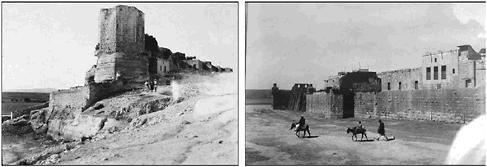Muslim Fortresses in the Levant: Between Crusaders and Mongols (101 page)
Read Muslim Fortresses in the Levant: Between Crusaders and Mongols Online
Authors: Kate Raphael
Tags: #Arts & Photography, #Architecture, #Buildings, #History, #Middle East, #Egypt, #Politics & Social Sciences, #Social Sciences, #Human Geography, #Building Types & Styles, #World, #Medieval, #Humanities

Al-Bīra as it was seen by Creswell
The entire medieval town of al-Bīra, which lay east of the citadel, was walled, hence in order to reach the fortress the town fortifications had to be overcome, which was no small matter (Figures
4.33
,
4.34
). Creswell dated the fortifications roughly to the eleventh and fifteenth centuries.
226
The damage left by the Mongols was repaired soon after al-Bīra was taken by the Mamluks in 1262. Ibn al-Furāt says: “He [Baybars] ordered the frontier town of al-Bīra to be built up.”
227
Ibn Shaddad writes: “a number of towers were built in the fortress, a gate was opened [ ,
,
meaning here to construct] facing the Euphrates, its moat was widened, and markets were built in the fortress and in its outskirts [ ].”
].”
228 says: “the Sultan constructed [
says: “the Sultan constructed [
ansha’a
] the fortress, built [
banā
] its towers, widened its moat and renewed its mosque.”
229
Enlarging the fortress would have been practically impossible due to the restrictions imposed by the topography. Thus the sultan mainly strengthened the existing fortress.

Figure 4.34
Al-Bīra, the town walls and the octagonal tower in the southern corner
Cliffs adorned with curtain walls
One of the most striking features of the site is its steep white cliffs. The shot ridge is completely detached from the landscape around it. The natural slopes ere made vertical by quarrying the soft limestone evenly all around (
Figure 4.35
). This gave the site much of its initial protection. Since the fortress walls and towers were built at the edge of the cliffs it was practically impossible to mine or sap the foundations. Although it had the protection of the forbidding cliffs, the fortress was also surrounded by a fosse that was filled in modern times and turned into a road.
230
The fortress is only 50m above the level of the river and yet it commands the entire landscape in such a way that no matter where an enemy positioned himself he was bound to be at a disadvantage.
The fortress measures approximately 300m in length and 60m in width. The layout follows the natural ridge and its shape resembles a kidney. The entire western side parallel to the river is devoid of towers. The height and steepness of the cliffs on this side provided sufficient protection. The remains of a wall and a gate near the river, suggest that the fortress grounds stretched all the way down to the bank. This lower section gave the garrison access to the river, a passage carved in the rock led down to the Euphrates.
The first inscription dates to the reign of Baybars’ son al-Malik Barka Khan (676/1277–678/1279): it commemorates the rebuilding of the curtain wall:
Barka Khan (676/1277–678/1279): it commemorates the rebuilding of the curtain wall:
(1) This blessed curtain wall was renewed in the reign of our lord the Sultan (?) al-Malik (2) the learned, the just, the fighter of holy wars
the learned, the just, the fighter of holy wars al-Dunyā wa’l-Dīn, (3) bringer of justice to those oppressed by oppressors, the eradicator of deviators and rebels
al-Dunyā wa’l-Dīn, (3) bringer of justice to those oppressed by oppressors, the eradicator of deviators and rebels Barka Khān (4) son of our lord, Sultan al-Malik
Barka Khān (4) son of our lord, Sultan al-Malik , partner of the Commander of the Faithful, may Allah perpetuate (5) his rule, under the command of the appointed governorship amir Jamāl al-Dīn, royal governor at al-Bīra.
, partner of the Commander of the Faithful, may Allah perpetuate (5) his rule, under the command of the appointed governorship amir Jamāl al-Dīn, royal governor at al-Bīra.
Since the inscription was found at the citadel we can be certain that the rebuilding of the “blessed curtain wall” refers to the fortress and not to the town defenses. No date is given though several clues occur in the inscription as to when and why this curtain wall was rebuilt. Barka Khan’s reign lasted only two years, before his father-in-law Qalāwūn seized power. Renovations could have taken place between 1277 and 1279, though it would be difficult to explain such a late date for the renovations of the wall. A more likely supposition is that the reconstruction work was carried out soon after the Īlkhānid siege of 1275. The appearance of Barka Khan’s name prior to his reign is possible seeing as Baybars appointed him co-sultan as early as 1268 in order to legitimize his succession.
232

